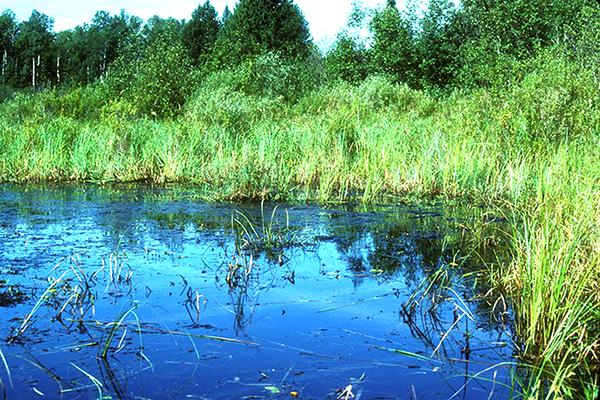An emergent wetlands captured in Mackinac County (Image: Alan Wolf via flickr)
By Vicki Browne
Iron County Lakes & Streams Partnership
IRON COUNTY — When Europeans first came to the U.S., about 221 million acres were wetlands. By the mid-1980s just over half of these original wetlands were lost. Some states, like Illinois and California, lost over 85% of their wetlands. Michigan lost about 50%.
Those early European settlers viewed wetlands as dangerous waste land, unsuitable for agriculture and teeming with diseases like malaria. Over a 200-year period, 4.2 million acres of wetlands in Michigan were either drained or filled to support agriculture (47% of former wetlands) and development (49% of former wetlands).
In 1989, the North American Wetlands Conservation Act authorized the U.S. Fish and Wildlife Service to oversee the North American Waterfowl Management Plan to provide grants and manage wetland habitats in the U.S., Mexico and Canada for migratory birds. Through an incentive-based program relying heavily on public-private partnerships, the plan has launched 2,800 projects targeting 29.8 million acres of wetlands across North America, according to Ducks Unlimited.
Given this dramatic shift in perspective, it’s worth knowing more about wetlands.
Wetlands are areas where water covers the soil, or is present at or near the surface of the soil all year. Wetlands are homes to both aquatic and land species. They’re found on every continent except Antarctica. In essence, they are transition zones that link land and water.
Coastal wetlands occur where the salt water of an ocean mixes with freshwater. Inland wetlands occur along the margins of lakes and ponds, in floodplains along rivers and streams and in low lying areas where precipitation saturates the soil. Some wetlands are seasonal, but all wetlands provide critical habitat for wildlife. They support as much diversity as rainforests and coral reefs.
Wetlands provide a link in the life cycle of 90% of recreational fish caught. For inland wetlands this includes yellow perch, small and largemouth bass. About half of the bird species in North America nest or feed in wetlands; and every species of duck, goose and swan rest and feed there as they migrate. Even though wetlands comprise only 5% of the land surface in the U.S., 31% of plant species grow there.
Wetlands protect lakes and streams by improving water quality. Water that will eventually reach a lake or stream gets filtered by plants that absorb nutrients. Suspended sediments and some pollutants settle in the wetland, purifying the water.
One acre of wetland can store over one-million gallons of floodwater. That’s about 1.5 olympic-sized swimming pools’ worth of water.
Wetlands are sponges for floodwaters and better than seawalls for waves. If an area’s wetlands are healthy, torrential rain events cannot cause nearly as much damage. Wetlands also absorb wave action, protecting shorelines from erosion by slowing the momentum of waves.
Inland wetlands might be classified as marshes, swamps, bogs or fens. Fens are not found in the U.P., but every other type of wetland occurs here.
Marshes occur in poorly drained areas, floodplains and shallow areas along lakes and rivers. Marshes are further broken down into wet meadows, wet prairies, prairie potholes and vernal pools — depending on how water gets to them and how long it stays. The vegetation in marshes is non-woody.
Michigan has many emergent marshes. These are shallow-water wetlands along the shores of lakes and streams. The plant life in emergent marshes include sedges, rushes, pickerel weed and cattails. Plants closest to open water are adapted to aquatic habitat, while grasses and sedges populate the drier edges.
Spawning fish depend on spring floods in emergent marshes, as do frogs, turtles and waterfowl. The dense plant diversity in emergent marshes is most threatened by purple loosestrife, an invasive species with lovely magenta flowers and a tendency to rapidly crowd out native plants.
Swamps are wetlands fed by surface water and filled with trees and shrubs. In the U.P., we have many conifer swamps — especially cedar swamps. Conifer swamps flow with cold, mineral-rich groundwater. They are found near lakes and have a thick, insulating layer of moss that prevents the ground from freezing until February, but then allows it to stay frozen until June. The plants in a conifer swamp get their water from nighttime condensation.
Cedar and tamarack tree roots form dense, shallow mats in these swamps. It is common to see many bent, leaning or fallen trees. The animals of the conifer swamp include deer and snowshoe hares who feed there, as well as beavers and muskrats who live there. Threats to conifer swamps include buckthorn and purple loosestrife.
Bogs are wetlands that are nutrient-poor and low in oxygen. Sphagnum moss carpets a bog. Stunted conifers like black spruce and tamarack grow in bogs, as do blueberries and cranberries.
The water of a bog comes from precipitation and the soil is usually acidic. Toads, frogs, garter snakes, beavers, minks, butterflies and moths depend on bogs.
If your interest in wetlands has been whetted, you can zoom in on your own neighborhood to see where the wetlands are using an interactive map from the Department of Environment, Great Lakes and Energy at mcgi.state.mi.us/wetlands/mcgiMap.html.


